Seikouba Sickle from Hida Tools: Product Review
We independently evaluate all recommended products and services. If you click on links we provide, we may receive compensation.
 If you’ve ever grown ornamental grasses, planted grass or grain cover crops, or dealt with weedy grasses in the garden, you know how hard it can be to cut them down with shears, hedge clippers, or even a string trimmer. If so, you may want to invest in one of the most ancient of harvesting tools – a sharp, wood-handled tool known as a sickle. Here’s why.
If you’ve ever grown ornamental grasses, planted grass or grain cover crops, or dealt with weedy grasses in the garden, you know how hard it can be to cut them down with shears, hedge clippers, or even a string trimmer. If so, you may want to invest in one of the most ancient of harvesting tools – a sharp, wood-handled tool known as a sickle. Here’s why.
New Plan of Action Required a New Tool
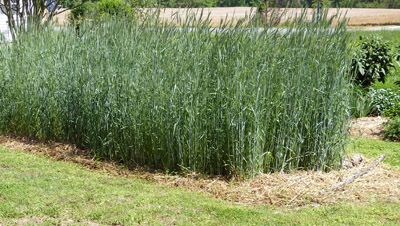 Several years ago, I started growing winter rye as a cover crop. I plant it in the fall and in the spring it reaches 5 to 6 feet before setting seed. When pollen is hanging on the rye in late spring (usually the first part of May here in Virginia) I cut the biomass of the rye and place it back on the bed as mulch. Warm weather seedlings like tomatoes, cucumbers, or squash can be planted right into the stubble of the rye.
Several years ago, I started growing winter rye as a cover crop. I plant it in the fall and in the spring it reaches 5 to 6 feet before setting seed. When pollen is hanging on the rye in late spring (usually the first part of May here in Virginia) I cut the biomass of the rye and place it back on the bed as mulch. Warm weather seedlings like tomatoes, cucumbers, or squash can be planted right into the stubble of the rye.
When I first used this strategy, I tried cutting the rye with hedge clippers. What a surprise that it wasn’t an easy job! It didn’t take much research to find that the proper tool for cutting grasses or grains by hand is a sickle, and it has been for thousands of years.
Matching the Sickle to the Job
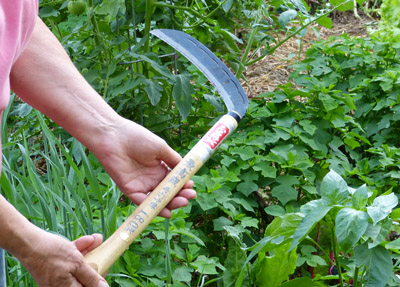
The Seikouba sickle is easy to handle
Since there are a variety of sickle shapes and sizes, each with different uses, I called Hida Tool before I ordered. The folks there were helpful in guiding me to the sickle I needed, which turned out to be the one with the medium blade (Item N-2112 with a 3/32-inch thick blade). Other Seikouba sickle options included a thin blade (Item N-2111 with a blade that’s only 1/16” thick) and a thick one that can deal with heavier material (Item N-2113, 1/8-inch thick blade).
Product Specs
- Overall length: 15.5″
- Blade length: 7″
- Blade thickness: 3/32″
- Weight: 6.5 oz
High Quality, Handmade Tool
The handle on this sickle is handmade in Japan of Japanese white oak and is extremely light-weight for easy handling.
As with any wood-handled tool, you should keep the handle dry when storing the sickle and, if needed, occasionally give it a light sanding with a fine-grit sandpaper and/or oil it. Having said that, I’ll also add that in the two years that I’ve had the Seikouba sickle, I’ve not oiled or sanded the handle and it still looks almost new.
The blade is made of high carbon steel laminated to soft steel. High carbon steel can be sharpened to an extremely fine edge but has the disadvantage of rusting easily if not properly cared for. Make sure the blade is dry before you put it away. It also helps to apply a drop of oil to both sides of the blade. Hida Tool recommends using Camellia Oil to preserve and protect the blade from rusting.
The blade is firmly riveted to the handle in a slotted area designed for it. I’ve never had any problems with it coming loose.
Keep It Sharp to Minimize Effort
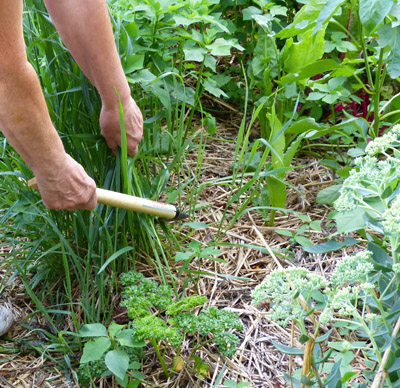
Be careful when using the Seikouba sickle. It’s meant to be kept extremely sharp so keep your hands and legs away when cutting grass.
The blades of a sickle are (and should be kept) extremely sharp. This is what minimizes the effort required to cut. I’ve had mine two years, and it has not needed to be sharpened. But the more use you have for it, the more often it’ll need sharpening.
Easy to Use But Be Careful!
Never having used a sickle before and seeing how sharp it was, I was very cautious. I wanted to make sure I cut the rye, not me! When I’m using a sickle, my full attention is on what I’m doing. And when I finish, I wipe the blade clean with a cloth. It immediately goes back into its sheath and back to the garage to its assigned place. Only then do I continue with the rest of the job.
How to Use a Sickle to Cut Grasses and Grains
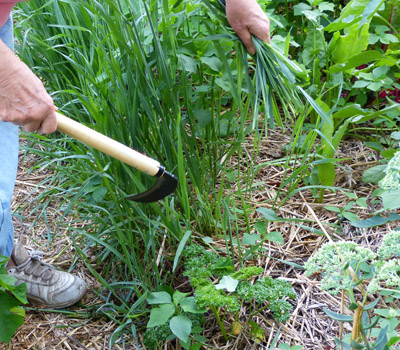
The Seikouba sickle makes quick work of grasses and grains
With one hand, grasp the rye (or grasses or other cover crop). Pull it taut. Holding the sickle in the other hand, place the blade at the base of the grass. Pull and the sickle will cut the grass at the base. Since you will be pulling the sickle blade towards you, take your time in getting used to how little or how much force is needed. It only took me two pulls to know what I needed to know. Being slow and thoughtful will help avoid accidents.
Use it Only as Intended
Now that I’ve used this tool, I see many other uses in my borders and garden for a sickle. However, with it’s thin blade and lightweight handle, the Seibouka sickle is made only for cutting fine grasses and grain crops. I plan to order Hida’s Kusakichi Noborigama (Branch Trimming Sickle) that is made for cutting heavier woody stemmed plants. The blade is thicker (it’s a full ¼ inch thick), it’s shaped a bit differently, and the sickle has a heavier handle, allowing you to tackle woody plants.
Recommendation
![]() I give the Seikouba Sickle a 5-shovel rating. It’s a high-quality, well-balanced, handmade tool that does the job it’s made to do. I would recommend it to anyone who wants to cut and manage cover crops and grasses by hand.
I give the Seikouba Sickle a 5-shovel rating. It’s a high-quality, well-balanced, handmade tool that does the job it’s made to do. I would recommend it to anyone who wants to cut and manage cover crops and grasses by hand.
Where to Buy
The Seikouba Sickle can be purchased online from the Hida Tool and Hardware Co. for $36.90 (plus shipping).
Enjoyed This Review?
If you liked this review, please sign up for our email updates with reviews, how-to articles and gardening videos!

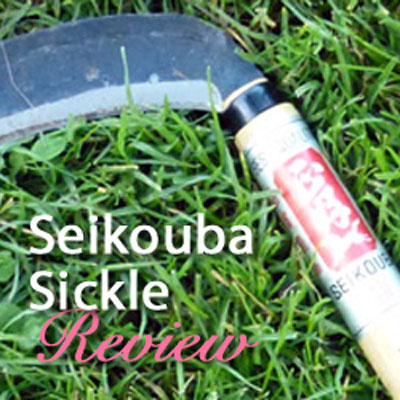

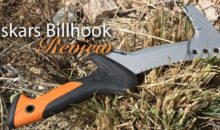
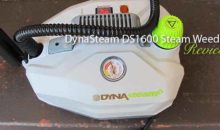
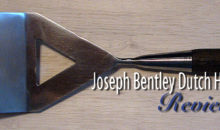
do you think it would be appropriate for Mugwort?
Susan, mugwort is an artemisia and most artemisias that I’ve grown have woody stems. You can use a sickle, but you’ll have to use one that is strong enough to cut the stems. The sickle I reviewed here is only suitable for grasses. Your best bet is to call Hida Tool and ask them which sickle would be suitable for woody stemmed plants.